There are many types of wood that are in use in our day-to-day life. Each wood type has a different function and appropriate use case. Wood is used in our houses in furniture, for making books and newspapers, for cooking food, and for many other uses.
Table of Contents
Wood is a renewable natural resource that is sustainable. Nowadays greenhouse gases and green buildings are a great concern. Wood can be the best material to be used as it offers environmental advantages and benefits.
Wood is processed and utilised in different ways such as plywood, wood pallets, lumber, fiberboard, rayon, acetate, paperboard, and many more.
Trees are cut and processed to form planks and beams that can be used in building or construction activities. These planks are also called lumber in US and Canada.
Wood has many uses in our day-to-day life like in fencing, garden boundary wall, partition, utility poles, fuelwood, organic chemicals, railway sleepers, bridge making, and textiles fibers.
The importance of wood in the US can be seen from the fact that it’s population being 5% it uses 28% of the total timber produced in the world
When wood is used as an alternative material it mitigates climate change as it removes carbon from the atmosphere. During photosynthesis carbon dioxide is consumed and oxygen is released during plant growth.
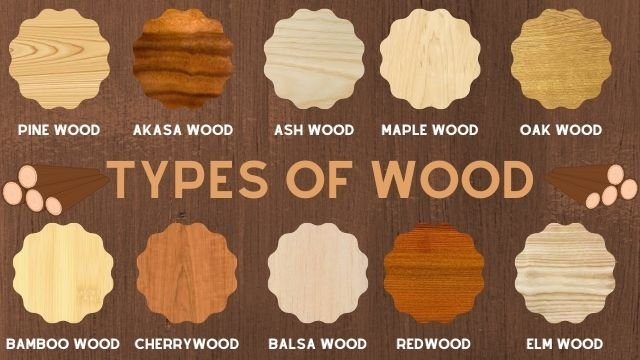
What is Wood
Wood is a porous fibrous structural tissue found in the trunks of trees. Each wood is different from the other wood and is used for suitable applications. Wood comes from trees and the properties of trees is what constitute wood property.
Softwood and Hardwood
Wood can be broadly classified as softwood or hardwood. Softwood is comparatively lighter than hardwood. Softwood mainly comes from coniferous or evergreen trees like redwood, pine, fir, cedar, etc. Hardwood comes from deciduous trees like maple, oak, teak, mahogany, birch walnut, etc.
Softwood can be easily dented with fingernails while hardwood is a bit difficult to do so. In comparison with hardwood, softwood loses and absorbs moisture easily. Thus extra care should be given to softwood to maintain its stability over time.
All hardwood is harder than softwood with the only exception of balsa wood. Following is a list of softwood and hardwood:
- Softwood
- Cedar Wood
- Pine wood
- Red wood
- Fir wood
- Hemlock wood
- Hardwood
- Oak wood
- Ash Wood
- Walnut wood
- Poplar wood
- Maple wood
- Balsa Wood
Softwood comes from coniferous evergreen trees. They are called evergreen because old leaves do not fall before new leaves are grown. Softwood trees are found in cold climatic areas. They grow easier as compared to hardwood thus they are cheaper.
Advantage of Wood
Wood is a very useful natural resource found in nature. There are many benefits of using wood in our buildings or construction. Some of the benefits of using wood are as follows:
- Wood use can reduce the ill effects of water and air pollution, and lowers the emission of greenhouse gases.
- Steel in comparison with wood uses 12% more energy and releases 15% more greenhouse gases. While concrete uses 20% more energy and releases 29% more GHG.
- Steel and concrete produce more water pollutants and air pollutants when compared with wood.
- Wood is an excellent insulator thus helping to slow the conductivity of heat.
- According to Life Cycle Assessment (LCA), Wood requires the least amount of energy in comparison to other building materials throughout its lifecycle of growth, harvest, transport, manufacture, and construction.
- When more wood is used it promotes the growth of trees and thus helps in preserving forests and nature.
Different Types of Wood
| Types of Wood | Hardwood or Softwood | Durability Class | Wood Origin | Wood Color | Characteristics and Uses |
|---|---|---|---|---|---|
| Cottonwood | Hardwood | 5 | North America | Light brown to yellowish-brown | Soft and light with low resistance to decay and insects. Used for pallets, crates, and paper pulp. |
| Butternut | Hardwood | 4 | North America | Light brown to dark brown | Light, soft, and easy to work with hand tools. Used for furniture, carvings, and interior trim. |
| Poplar | Hardwood | 4 | North America | Light brown to yellowish-brown | Soft and lightweight with low resistance to decay and insects. Used for furniture, cabinets, and pallets. |
| Chestnut | Hardwood | 3 | North America | Light brown to dark brown | Medium density with good workability and moderate decay resistance. Used for fencing, posts, and rustic furniture. |
| Pine | Softwood | 3 | North America | Light brown to yellowish-brown | Soft and lightweight with low to medium decay resistance. Used for construction, paneling, and furniture. |
| Spruce | Softwood | 3 | North America | Light brown to yellowish-brown | Soft and lightweight with low to medium decay resistance. Used for construction, paper pulp, and musical instruments. |
| Elm | Hardwood | 2 | North America, Europe, Asia | Light brown to medium brown | Moderately heavy with good resistance to splitting and moderate decay resistance. Used for furniture, flooring, and shipbuilding. |
| Maple | Hardwood | 2 | North America, Europe, Asia | Light brown to reddish-brown | Heavy and strong with good workability and moderate decay resistance. Used for flooring, furniture, and musical instruments. |
| Birch | Hardwood | 2 | North America, Europe, Asia | Light brown to yellowish-brown | Heavy and strong with good workability and moderate decay resistance. Used for cabinetry, flooring, and turnery. |
| Ash | Hardwood | 2 | North America, Europe, Asia | Light brown to medium brown | Heavy and strong with good shock resistance and moderate decay resistance. Used for tool handles, flooring, and furniture. |
| Cherry | Hardwood | 2 | North America, Europe, Asia | Light brown to reddish-brown | Moderately heavy with good workability and moderate decay resistance. Used for cabinetry, furniture, and decorative veneers. |
| Mahogany | Hardwood | 2 | Central and South America | Reddish-brown to dark brown | Heavy, strong, and durable with excellent workability and decay resistance. Used for furniture, paneling, and boatbuilding. |
| Jatoba | Hardwood | 2 | South America | Reddish-brown to dark brown | Very hard and dense with good decay resistance. Used for flooring, furniture, and decorative veneers. |
| Brazilian Cherry | Hardwood | 2 | South America | Medium brown to reddish-brown | Hard and durable with good decay resistance. Used for flooring, furniture, and cabinetry. |
| Ipe | Hardwood | 1 | South America | Dark brown to reddish-brown | Extremely hard, dense, and durable with high resistance to decay and insects. Used for decking, outdoor furniture, and heavy construction. |
| Teak | Hardwood | 1 | Southeast Asia | Golden-brown to dark brown | Strong, durable, and resistant to decay and insects. Used for boatbuilding, outdoor furniture, and flooring. |
| Hickory | Hardwood | 1 | North America | Light brown to reddish-brown | Very hard and strong with good shock |
Following are different types of wood available in the market for different purposes.
Akasa Wood

Akasa Wood is a durable type of heartwood and sapwood that is grey-brown in color. The main application of Akasa wood is in utility furniture, light structural work, flooring, interior joinery work, plywood, and turnery.
Akasa wood is a straight-grained sapwood. Its density and hardness along with its durability make it the preferred choice of woodworker for home furniture. With proper workmanship, one can expect long-lasting furniture.
Characteristics of Akasa Wood
| Scientific Name | Chrysophyllum Albidum |
| Color | Deep brown |
| Source | Australian-Native Trees |
| Density | 700kg/m³ at 12-15% moisture content |
| Hardness | 1320 on Janka Scale |
| Common Uses | Furniture, floors, cabinets, etc. |
Ash Wood
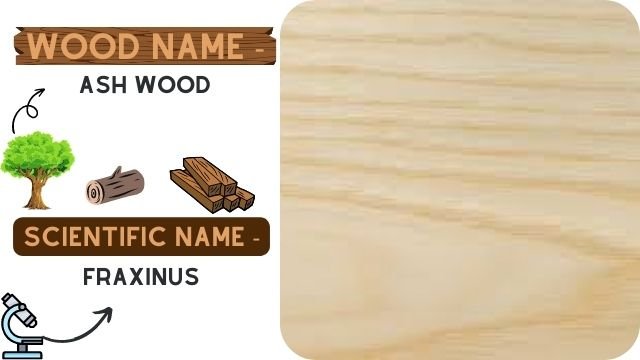
Ash wood is a light colour smooth-grained hardwood that offers luster when polished. It is hard-wearing open-grained structural wood. Ashwood can be stained in any colour of choice.
Ashwood grows on the east coast and parts of Canada. It has sufficient high strength and good weight and is shock resistant. It is attractive, durable, aesthetically pleasing, lightweight, and absorbs wood stains perfectly. All these properties of Ash wood make it perfect for fine furniture.
Characteristics of Ash Wood
| Scientific Name | Fraxinus |
| Color | Beige or light brown |
| Source | White Ash Tree (Fraxinus Americana L.) |
| Density | 1320 on the Janka scale |
| Cost | $2.50 to $7.00 per board foot |
| Common Uses | Furniture, floors, cabinets |
Maple Wood
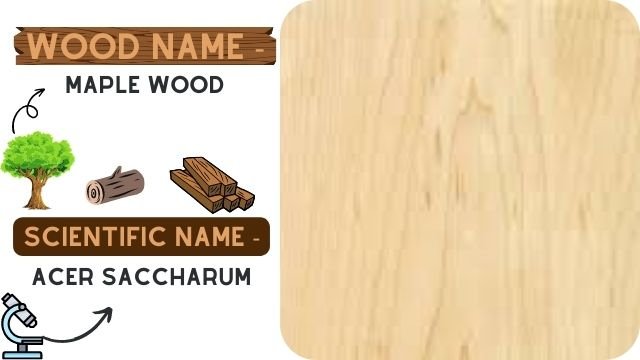
Maple is found in Canada and is one of the hardest wood species. It is a strong and hard wood and has high resistance to knocks. Maple in its natural state is smooth grain, unique color and high strength this makes it a popular choice of woodworkers for all work.
Maple wood is commonly used in Flooring, Cabinetry, Kitchen accessories, and many more uses. Maple has straight grains and irregular patterns which contain fiddle back and bird eye patterns. Maple wood has white sapwood with some reddish-brown hues.
Characteristics of Maple Wood
| Scientific Name | Acer Saccharum |
| Color | White with some reddish-brown hues |
| Source | Acer Saccharum |
| Density | 689 kg/m3 |
| Hardness | 1450 on the Janka scale |
| Common Uses | Flooring, Cabinetry, and Kitchen accessories. |
Oak Wood

Oak wood is a straight grained heavy, hard-wearing strong wood. Because of its high density of 897kg/m3 and high strength, it is widely used in the construction industry.
Oak wood has straight grained and colour varies from light to medium brown. It is the first choice of construction timber. It is also called red oak due to its autumnal foliage having more flecks and a defined-grained finish.
Oak is stronger than mahogany and many other top timbers. It is highly durable and thus furniture and flooring made from oak wood last long. Oak wood is used for flooring, paneling, cabinet, furniture, etc.
Characteristics of Oak Wood
| Scientific Name | Quercus |
| Color | Pale-red to reddish/brown |
| Source | Oak tree |
| Density | 897 kg/m3 |
| Hardness | 1360 on Janka scale |
| Common Uses | Flooring, paneling, cabinet, furniture, etc. |
Balsa Wood
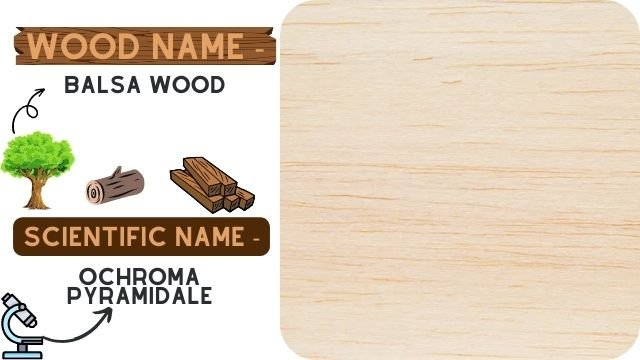
Balsa wood in spite of being a hardwood is one of the softest and most lightweight wooden timber. Strength to weight ratio of balsa wood is excellent in comparison with other wood. It is an excellent fire performance and an ecological product.
Due to the properties of balsa wood, it is widely used in model making and for heat, sound, and vibration insulation. Balsa wood is used to make Buoys, rafts, surfboards, model airplanes, musical instruments, etc.
Characteristics of Balsa Wood
| Scientific Name | Ochroma Pyramidale |
| Color | Pale reddish-brown |
| Source | Balsa tree |
| Density | 120-160kgm3 |
| Cost | $2.50 to $7.00 per board foot |
| Common Uses | Buoys, rafts, surfboards, model airplanes, musical instruments, etc. |
European Oak Wood
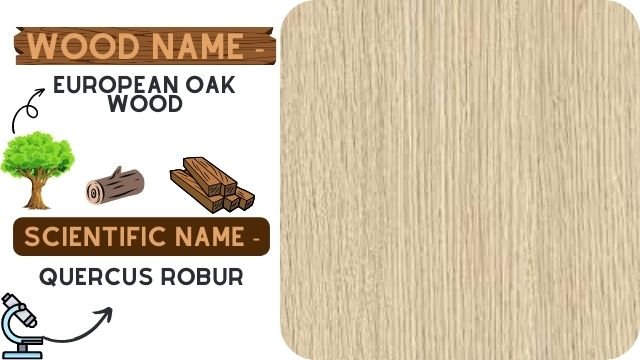
European oak wood as the name suggests is natively found in European countries like France, England and Germany. Oak, Europan Wood has pale yellow-brown colour.
Oak, European wood is a hardwood that is comparatively hard, heavy and stronger than its American counterpart Oak. American Oak has clean and subtle grain patterns with a uniform appearance while European oak is a distinctive variation contributing to its unique wavy charm.
Oak, European wood is used in furniture, interior trim, flooring, boatbuilding, etc.
Characteristics of European Oak Wood
| Scientific Name | Quercus Robur |
| Color | Pale yellow-brown |
| Source | European Oak Tree |
| Density | 720 kg/m³ |
| Hardness | 1360 on Janka scale |
| Common Uses | Furniture, interior trim, flooring, boatbuilding, etc. |
Recommended for you:
- Standard Size Of Column
- Standard Room Sizes and Room Area – Detailed Information
- Standard Door Size
- Detailed Information On Pipes | Types Of Pipes | Different Plumbing Pipe and its Uses
- Thumb Rules In Building Construction For Civil Engineers | Important Point Of Civil Engineering | Construction Thumb rules
Bamboo Wood

Bamboo is a rich golden colour hard wearing wood. Bamboo wood is made from bamboo that has tensile strength greater than steel. Bamboo wood is 2 to 3 times harder than other hardwoods like oak.
Due to resistance to moisture and humidity bamboo is widely used as an ornamental part of a water point or bathroom flooring and in other wet areas. It is also used in Veneer, paper, fishing rods, ladders, scaffolding, musical instruments, furniture, window blinds, carving, turned items, and small novelty items.
Characteristics of Bamboo Wood
| Scientific Name | Bambusa Vulgaris |
| Color | Rich golden |
| Source | Bamboo tree |
| Density | 1160 kg/m3 with a moisture content of 7% |
| Cost | $2.00 to $4.00 per bamboo |
| Common Uses | Scaffolding, Roofing, Flooring, etc. |
Greenheart Wood
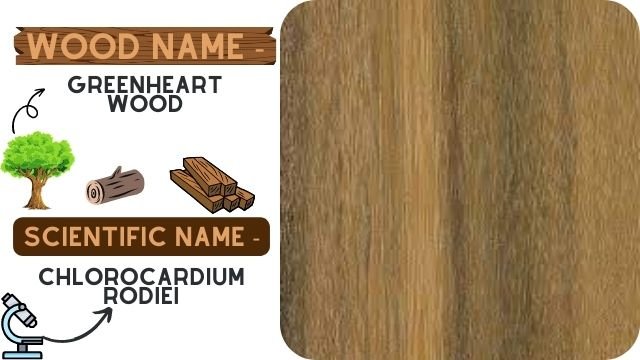
Greenheart wood is highly durable and resistant to insect attacks. Greenheart is considered one of the stiffest wood in the world, with an average modulus of elasticity of 3,716,000 lbf/in2. Greenheart requires no treatment and it’s 3 to 4 times stronger than fir or pine wood.
It is also extremely dense and does not float. Colour of Greenheart lumber is pale olive green with darker streaking sometimes prevalent. Green heart wood is mainly used in pilings for wharves and bridges and in ships.
Characteristics of Greenheart Wood
| Scientific Name | Chlorocardium Rodiei |
| Color | Pale olive green |
| Source | Laurel tree |
| Density | More than 960 kg/m3 |
| Physical property | Durable and stiffest wood |
| Common Uses | Pilings for wharves and bridges and in ships |
Beech Wood
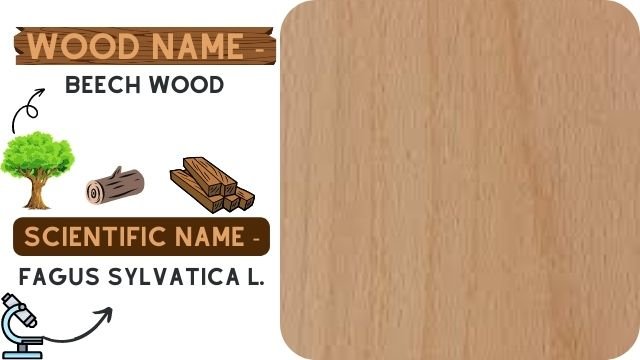
Beech Wood is a type of hardwood that is hard and durable that has many varieties of warm, soft honey tones. Beech when treated at high temperatures creates unique red colour. Beechwood comes from the queen of the woods tree the name given to the beech tree.
It is one of the most preferred choices of hardwood in Europe. The strength, hardness, bending capabilities, and wear resistance properties of beech wood is exceptional.
Characteristics of Beech Wood
| Scientific Name | Fagus Sylvatica L. |
| Color | Reddish-brown |
| Source | Deciduous trees |
| Density | 700 – 900 kg/m3 |
| Cost | $6.00 per board foot |
| Common Uses | Furniture, Cabinetry, Cooking utensils, etc. |
Meranti Wood
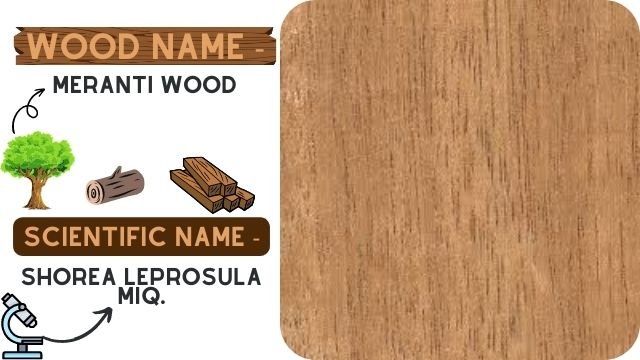
Meranti wood is hardwood that has 5 groups of timber based on colour of heartwood. It comes in 5 different colour which are dark red meranti, light red meranti, white meranti, yellow meranti, and balau.
- Dark red meranti and red lauan are medium to dark-red brown hardwoods used for interior and exterior joinery and for plywood
- Yellow meranti or are yellow-brown hardwoods, used for interior joinery and plywood
- Light red meranti and white lauan, are pale pink to mid-red hardwoods, used for interior joinery and plywood
White Meranti is around twice the price of pine, but it is also far more durable. Meranti is most suited for exterior use. Meranti can be used as an external timber without treatment. Meranti wood is 30% to 40% cheaper than Oak. It is used for Molding, furniture, structure, window, etc.
Characteristics of Meranti Wood
| Scientific Name | Shorea leprosula Miq. |
| Color | Pale-red to reddish/brown |
| Source | Tropical Shorea tree species |
| Density | 710 kg/m3 |
| Hardness | 825 Janka Hardness |
| Common Uses | Molding, furniture, structure, window, etc. |
Pine Wood

Pine wood is an inexpensive hardwood easily found in nature than other traditional hardwood. Pinewood timber color varies from pale yellow to almost red in appearance.
Pine wood is hard-wearing and dent-withstanding wood even in high-traffic areas. Thus its Is used in making doors, windows, partitions, decks, railings, paneling, etc.
Characteristics of Pine Wood
| Scientific Name | Pinus |
| Color | Creamy White Hue / Yellow |
| Source | Pine Tree |
| Density | 990 kg/m³ |
| Hardness | 690 on Janka Scale |
| Common Uses | Making doors, windows, partitions, decks, railings, paneling, etc. |
Brazilian Mahogany Wood

Brazilian mahogany is generally known as Genuine mahogany in the US. Brazilian mahogany wood is denser in comparison with African mahogany wood.
The primary use of Brazilian mahogany wood is in making boats, musical instruments and furniture.
Characteristics of Wood
| Scientific Name | Swietenia Macrophylla |
| Color | Pale pink to medium reddish-brown |
| Source | Swietenia mahagoni trees |
| Density | 472 kg/m3 (< 40 years old) to 549 kg/m3 (> 40 years old) |
| Cost | $7.50 to $11.00 per board foot |
| Common Uses | Boats, furniture, Musical instrument, etc. |
Pitch Pine Wood

Pinus rigida known as pitch pine is a straight-grained medium textured wood. Pitch pine wood is native to North America. The American pine softwood has better strength and durability as compared to other pines. Its wood is rough-grained and contains a lot of resins.
Pitch pine can grow up to 60 feet and its diameter is up to 1 to 3 feet. Pitch pine wood is reddish brown in appearance. Commercially graded pitch pine wood is utilised in construction work. It is used in used for pulpwood, crating, fuel, shipbuilding, fences, and railroad ties.
Characteristics of Pitch Pine Wood
| Scientific Name | Pinus Rigida |
| Color | Reddish brown |
| Source | Pinus Rigida Tree |
| Density | 590 kg/m³ |
| Hardness | 620 Janka Hardness |
| Common Uses | Pulpwood, crating, fuel, etc. |
Cedar Wood
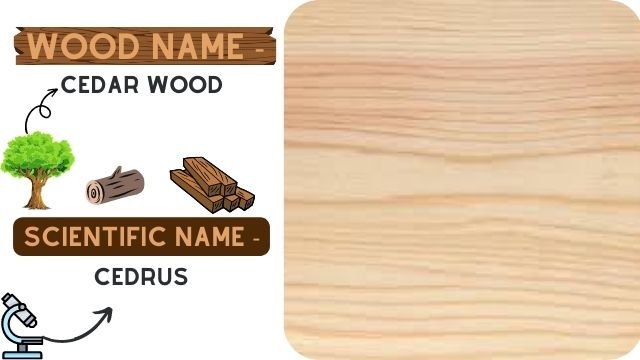
Cedar is a softwood that is durable and weather resistant and used for external application. Pleasant appearance and aromatic smell and natural inspect repelling wood becomes handy for home furniture.
There are more than 15 varieties of cedar wood found in nature. Each cedar wood is different from the others in terms of colour, rot resistance, and hardness.
Cedar wood is mainly used in boundary fences, storage boxes, siding, decking, and many other uses.
Characteristics of Cedar Wood
| Scientific Name | Cedrus |
| Color | Pinkish-red color |
| Source | Coniferous Trees |
| Density | 380 kg/m3 |
| Cost | $4 to $8 per linear foot |
| Common Uses | Fence, storage boxes, siding, decking, etc. |
Poplar Wood
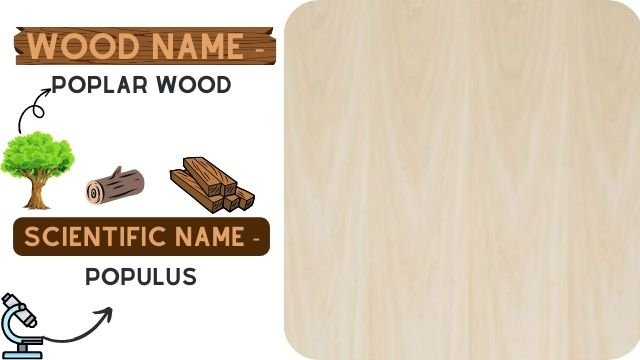
Poplar wood color is pale, light and soft with colour colour varying from light brown to creamy yellow. The sapwood of poplar wood is slightly paler in colour than its heartwood.
It is the second most used timber raw material for cellulose and pulp paper after conifers. Poplar wood comes from the tulip trees. It Is used in making toys, carvings, plywood, crates, pallets, and furniture frames.
Characteristics of Poplar Wood
| Scientific Name | Populus |
| Color | Light brown to creamy yellow |
| Source | Tulip Tree |
| Density | 500 kg/m³ |
| Hardness | 540 on Janka hardness |
| Cost | $3.20-4.85 per board foot |
| Common Uses | Toys, carvings, plywood, crates, pallets, furniture frames |
Teak Wood

Teak wood is a smooth textured, fine-grain yellow-brown hardwood. Teakwood is used in making window and doors frame and furniture.
Teak wood contains natural oils that fight against insects, termites, and rot. Teak wood is durable wood thus it is used in construction.
Teak wood is mostly grown in Burma and Thailand and its plantation has grown manifold. It is used in the manufacture of outdoor furniture and boat decks.
Characteristics of Teak Wood
| Scientific Name | Tectona Grandis |
| Color | Honey Brown or Tawny Gold |
| Source | Teak Tree (Tectona grandis) |
| Density | 740 kg/m³ |
| Cost | $7 to $41 per board foot |
| Common Uses | Manufacture of outdoor furniture and boat decks |
Celtis Wood
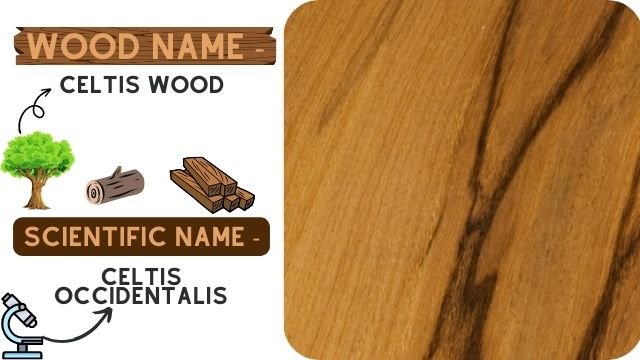
Celtis wood is also known as Hackberrries or nettle trees. It is straight grained sometimes interlocked wood patterns.
Heartwood that is the inner wood and sapwood is grey to yellowish in colour. Celtis wood is fine textures and has a lustrous look. Celtis wood is used in Cabinetry, decking, flooring, trim, etc.
Characteristics of Celtis Wood
| Scientific Name | Celtis Occidentalis |
| Color | Grey to yellowish color |
| Source | Deciduous trees |
| Density | 600-785 kg/m³ at 12% moisture content |
| Cost | $4.50 to $10.00 per board foot |
| Common Uses | Cabinetry, decking, flooring, trim, etc. |
Conifer Wood
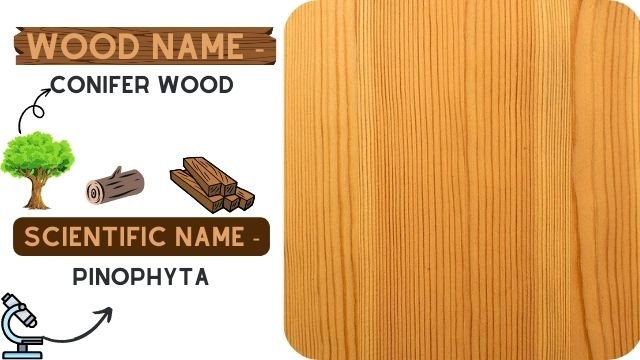
Conifer wood comes from coniferous or cone-bearing trees. These trees are evergreen and tree have needle-like leaves and produce softwood timber. Conifer wood is a homogeneous structure with 90% tracheids that is wood cells. Conifer wood is mainly used for making box, crates, papers, etc.
Characteristics of Conifer Wood
| Scientific Name | Pinophyta |
| Color | Vibrant Yellow or Gold |
| Source | Coniferous trees |
| Density | 480 kg/m³ |
| Cost | $3.50 to $15.00 per board foot |
| Common Uses | box, crates, papers, etc. |
Cherry Wood
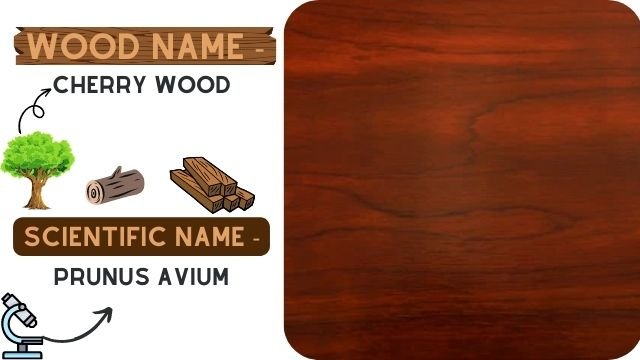
Furniture made from cherry wood is the most prized hardwood furniture in US. The natural beauty and grains of cherry wood make it the best choice for flooring and wall paneling. Cherry is a deciduous hardwood that is reddish brown to blond.
Cherrywood trees are fast-growing trees that are 10 to 25-meter height. The lifespan of the cherry tree is about 100 years. The trunk of cherry wood is straight and cylindrical in shape. Cherry wood is the most desirable wood to make your home furniture.
Cherry wood is widely used in carving because of its soft characteristics that make molding in any shape easier and also its ability to hold the shape is phenomenal.
Characteristics of Cherry Wood
| Scientific Name | Prunus Avium |
| Color | Light pink to rich reddish-brown |
| Height of tree | 10 to 25 meters |
| Lifespan of tree | 100 years |
| Source | Cherry tree |
| Density | 630 kg/m³ |
| Cost | $5.50 to $15.00 per board foot |
| Common Uses | Flooring, carving, furniture,etc. |
Walnut Wood
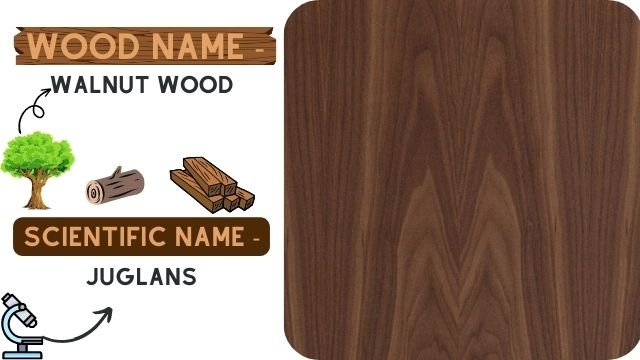
Walnut wood is a dark and dense tight grained hardwood. It comes in dark brown to yellowish colour appearance. Walnut wood grain is mostly straight but sometimes it can be irregular as well.
Walnut wood is used for furniture, musical instruments, carvings, trims, and veneers.
Characteristics of Walnut Wood
| Scientific Name | Juglans |
| Color | Light brown to dark chocolate |
| Source | Juglans regia |
| Density | 689 kg/m³ |
| Hardness | 1010 on Janka Scale |
| Common Uses | Furniture, musical instruments, carvings, trims, and veneers |
Dahoma Wood

Dahoma wood is a hardwood that is yellowish to reddish brown in colour. Trees that produce dahoma wood are generally 30m high and 1 meter in diameter.
The sapwood of dahoma wood is white to greyish red while the heartwood is light to a golden brown. It is high-density wood. Dahoma wood is mainly used for heavy construction, boatbuilding, docks, flooring, cabinetry, furniture, etc.
Characteristics of Dahoma Wood
| Scientific Name | Piptadeniastrum Africanum |
| Color | Yellowish to redish brown |
| Source | Tall deciduous tree |
| Density | 610 kg/m3 |
| Cost | $5.50 to $15.00 per board foot |
| Common Uses | Heavy construction, boatbuilding, flooring, cabinetry, furniture, etc. |
Sitka Spruce Wood
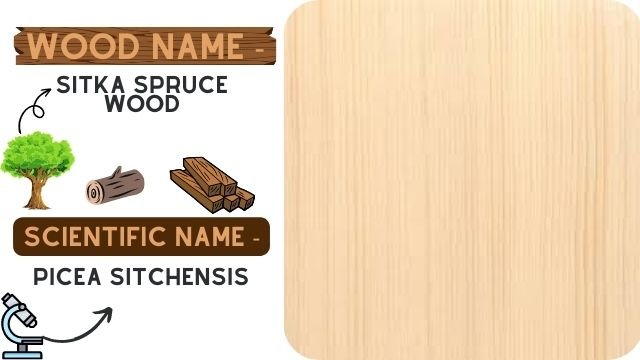
Sitka spruce wood comes in fine, even textured straight-grained wood with high strength to weight ratio. It is the largest of spruces and can grow up to 100 meter high and 2 meters in diameter. It is found on the Pacific coast. Sitka Spruce is a softwood generally used in general construction, shipbuilding, and plywood.
Characteristics of Sitka Spruce Wood
| Scientific Name | Picea Sitchensis |
| Color | Light pinkish-brown |
| Source | Picea sitchensis tree |
| Density | 347 kg/m³ |
| Hardness | 510 on Janka Scale |
| Common Uses | General construction, shipbuilding, and plywood |
European Beech Wood
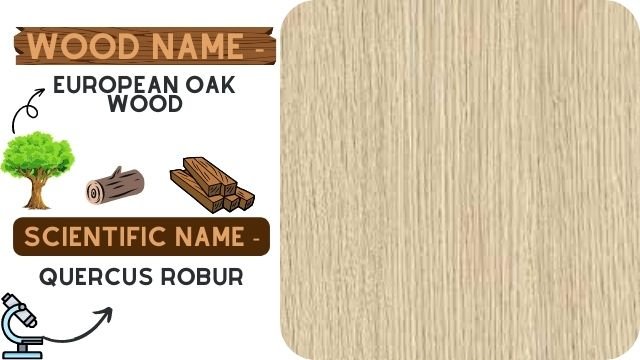
Fagus sylvatica that is commonly known as European Beech wood has medium stiffness and high crushing strength with medium resistance to shock loads. European beech wood is straight-grained and even textured wood mostly found in Europe. It is mainly used for Interior joinery, plywood, flooring, furniture, etc.
Characteristics of European Beech Wood
| Scientific Name | Fagus Sylvatica |
| Color | Pale cream |
| Source | European BeechTree |
| Density | 752 kg/m3 |
| Physical Property | Heavy, strong and resistant to shock |
| Common Uses | Interior joinery, plywood, flooring, furniture, etc. |
Southern Yellow Pine Wood

Southern yellow pine wood is one of the main sources of softwood in the United States of America. It grows in the south and west of the US.
It is used in the interior and exterior of home construction as it is easy to work and finishes well with very few defects.
Characteristics of Southern Yellow Pine Wood
| Scientific Name | Pinus Echinata |
| Color | Light yellowish-orange to dark reddish or yellowish-brown |
| Source | loblolly pine (Pinus taeda), long-leaf pine (Pinus palustris), shortleaf pine (Pinus echinata) and slash pine (Pinus eliottii) |
| Density | 670 kg/m³ |
| Hardness | 870 on Janka hardness Scale |
| Common Uses | Pallets, crating, and packaging |
Khaya Wood

Khaya wood is called as African mahogany and is considered an alternative to American mahogany. Compared to mahogany it is brittle but has acceptable working properties thus used as an alternative to it.
Khaya wood is lighter in weight than Brazilian mahogany with a coarser texture. The properties of khaya wood are similar to Honduras mahogany even though its appearance is similar. It is widely used in General beam, door frame, and shelving timber work.
Characteristics of Khaya Wood
| Scientific Name | Khaya Senegalensis |
| Color | Reddish-brown |
| Source | African mahogany |
| Density | 812.07 kg/m3 |
| Cost | $3.50 to $10.00 per board foot |
| Common Uses | General beam, door frame, and shelving timber |
Utile Wood

Utile wood plantation is done in West Africa. It is an appealing wood that is used in furniture, interior and exterior joiner for doors and window frames, countertops, cabinetry, decorative veneers and plywood. It is also used in boat construction, sports equipment and musical instruments.
Utile wood grain is interlocked with medium uniform texture and natural luster. It is also known as sipo and is used as an alternative to Mahogany.
Characteristics of Utile Wood
| Scientific Name | Entandrophragma Utile |
| Color | Tawny Golden |
| Source | Entandrophragma utile tree |
| Density | 740 kg/m³ |
| Hardness | 1260 on Janka Scale |
| Common Uses | Boat construction, sports equipment and musical instruments |
Danta Wood

Danta wood is light brown with pink tinge and has a heartwood reddish brown. The surface of danta wood has a lustrous look. Danta wood is commonly used for high-quality joinery, cabinetwork, benchtops, boat components, and decking work.
Characteristics of Danta Wood
| Scientific Name | Wrightia Tinctoria |
| Color | Light Brown |
| Source | Danta Tree |
| Density | 750 kg/m³ when dried |
| Common Uses | boat, benchtops, cabinetwork, etc. |
Elm Wood
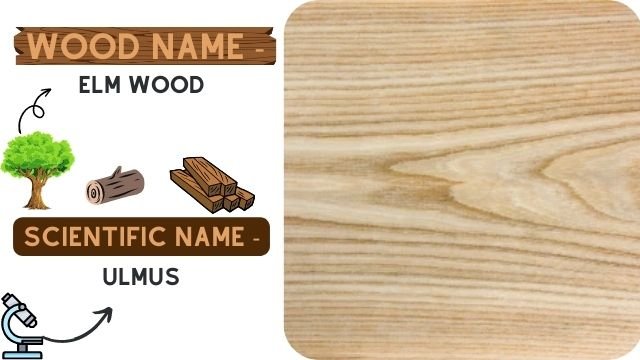
Elm is a hardwood that is similar to oak grains. The grains of elm wood is equally diverse and have straight to wavy patterns. The heartwood of elm is light to medium reddish brown colour and the sapwood is off-white.
Elms grains are interlocked which makes them durable and hard to split. It offers shock resistance. It has medium moisture resistance and coarse texture. Elmwood is mostly used in constructing boats and farm buildings.
Characteristics of Elm Wood
| Scientific Name | Ulmus |
| Color | White or grayish-white |
| Source | Ulmaceae Tree |
| Density | 560 kg/m3 |
| Wood Type | Hardwood |
| Texture | Coarse |
| Janka Hardness | 830 |
| Common Uses | Constructing boats and farm buildings |
Opepe Wood
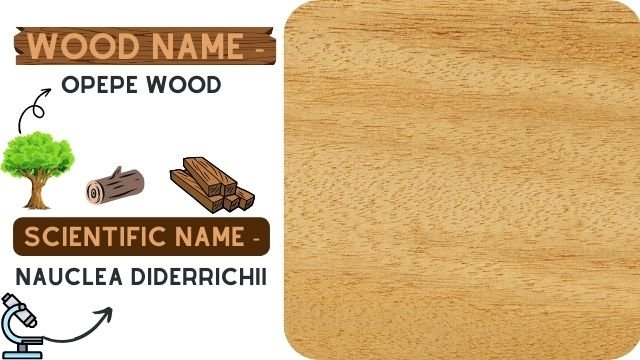
Opepe is a tropical hardwood from Central and Western Africa. Opepe wood is hard, durable wood that is moderately heavy in comparison to other wood. Its tree measures from 35 m to 50 m height and is 1 m to 2 m in diameter.
Opepe timber is also known as Bilinga and Aloma. Timber of opepe tree are colorful ranging from golden to orange-yellow. It is primarily used in heavy construction, marine, and freshwater construction, and for exterior joinery and flooring.
Characteristics of Opepe Wood
| Scientific Name | Nauclea Diderrichii |
| Color | Golden-yellow or orange-brown |
| Source | Nauclea diderrichii trees |
| Density | 750 kg/m³ |
| Hardness | 1630 on Janka Scale |
| Common Uses | Carving, interior trim, etc. |
Sapele Wood
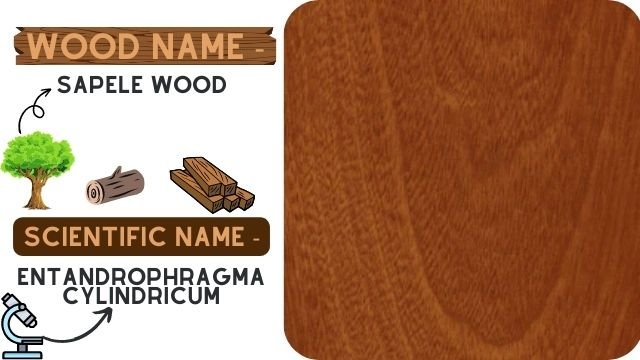
Sapele wood has marked and regular stripes on quarter-sawn surfaces. Grain is interlocked and closed texture wood. Sapele is heavier than African mahogany. It is 100-150 feet in length and 3 to 5 feet in diameter.
Sapele wood is also known as aboudikro, saplewood, sapelli, and Sapele Mahogany. It is native to tropical Africa being one of the largest trees in the area. It is grown in South East Asia with a medium reddish brown in appearance.
Characteristics of Sapele Wood
| Scientific Name | Entandrophragma Cylindricum |
| Color | Golden to dark reddish-brown |
| Source | Entandrophragma cylindricum tree |
| Density | 640 kg/m³ |
| Hardness | 1410 on Janka scale |
| Common Uses | Furniture, conservatories, door frames, etc. |
Iroko Wood

Iroko wood has yellow-brown hardwood with interlocked and irregular grains. This wood is mostly found in West Africa. Iroko wood is the cheaper alternative to teak wood and is mostly used in construction and exterior joinery work.
Iroko wood is a tough, dense, highly durable hardwood with a rich-colored grain. The scientific name of Iroko wood is Milicia excelsa.
Characteristics of Iroko Wood
| Scientific Name | Milicia Excelsa |
| Color | Yellow-brown |
| Source | Iroko Tree |
| Density | 660 kg/m3 |
| Grain types | Open interlocked grain |
| Common Uses | Construction and infrastructure work |
Whitewood European Wood

Whitewood European wood is grown in Europe, The Russian Common Wealth and The Baltic States. It is a commercial group of white to pale yellowish brown softwood with natural lustre. It is used in construction work, joinery and flooring.
Characteristics of Whitewood European Wood
| Scientific Name | Picea Abies, Abies alba |
| Color | White to pale yellowish-brown |
| Source | Silver fir (Abies alba) and Norway spruce (Picea abies) |
| Density | 480 kg/m³ |
| Common Uses | Construction, joinery, and flooring |
Ligneous Wood
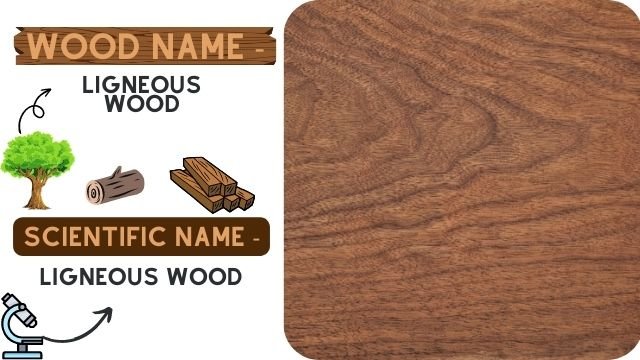
Ligneous wood is comparatively cheaper and more affordable in comparison with teak, pine, etc. Ligneous wood comes from cereal straw, bagasse, bamboo, and flax or hemp shives. Ligneous wood is used for making cupboards, kitchen cabinets, etc.
Characteristics of Ligneous Wood
| Color | Light Brown |
| Source | Ligneous plants |
| Density | More than 0.35g/cm3 |
| Common Uses | Cupboard, Kitchen Cabinets |
Douglas Fir Wood

Douglas fir wood is very popular wood because of its awesome strength-to-weight ratio. This makes it suitable for heavy structural use like column and beam construction. It is also used in glue-laminated beams and doors.
Douglas fir wood is light reddish brown in colour. It is widely used in Plywood, flooring, cabinetwork, etc. Scientific name of Douglas fir wood is Pseudotsuga menziesii.
Characteristics of Douglas Fir Wood
| Scientific Name | Pseudotsuga Menziesii |
| Color | Light Reddish Brown |
| Source | Pine Tree species |
| Density | 510 kg/m³ |
| Cost | $9.95/sq ft |
| Common Uses | Plywood, flooring, cabinetwork, etc. |
Okoume Wood
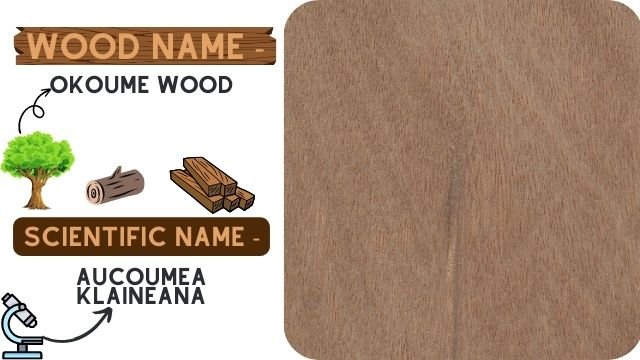
Okoume wood is only found in the forest of Gabon. Okoume wood is a softwood with a fibrous texture and irregular grains that looks similar to mahogany.
Okoume tree logs are cylindrical in shape which is best to produce veneer sheets as it is easier to slice and peel to make sheets.
Okume wood is pale pink to light brown and usually with a reddish shade in colour. Source of Okume wood is the Aucoumea klaineana tree. It is mostly used in furniture, cabinets, etc.
Characteristics of Okoume Wood
| Scientific Name | Aucoumea Klaineana |
| Color | Pale pink to light brown |
| Source | Aucoumea klaineana Tree |
| Density | 430 kg/m³ |
| Hardness | 380 on Janka Scale |
| Common Uses | Furniture, cabinets, etc. |
Redwood, European
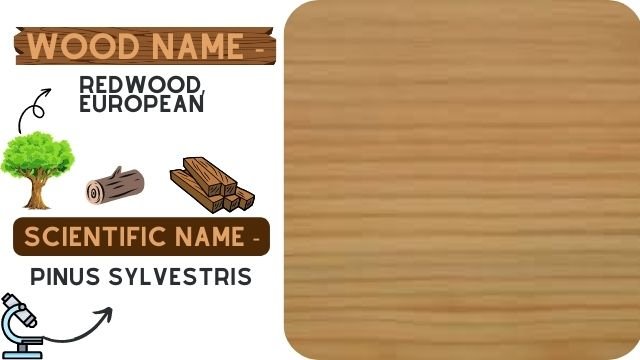
European redwood also known as Pinus Sylvestris or Scandinavian Redwood is a softwood. Redwood is found in Russian Commonwealth, Baltic States, and Scandinavia. It is also known as scots pine or British pine in UK.
European redwood is pale yellow-brown to red-brown in appearance. It is widely used in furniture, joinery, and construction.
Characteristics of Redwood European
| Scientific Name | Pinus Sylvestris |
| Color | Pale yellow-brown to red-brown |
| Source | Scandinavian Redwood |
| Density | 520 kg/m³ |
| Hardness | 510 on Janka Scale |
| Common Uses | Decking, structural beams, furniture, etc. |
Western Hemlock Wood

Western Hemlock wood is found in North America with pale brown softwood. It has a fine texture uniform straight grain structure. Western hemlock has good strength-to-weight ratio and is known for its working properties. It is used in construction, roof decking, plywood, etc.
Characteristics of Western Hemlock Wood
| Scientific Name | T. Heterophylla |
| Color | Pale brown |
| Source | Tsuga Tree |
| Density | 420 kg/m³ |
| Hardness | 540 on Janka Scale |
| Common Uses | Construction, roof decking, plywood, etc. |
Western Red Cedar Wood
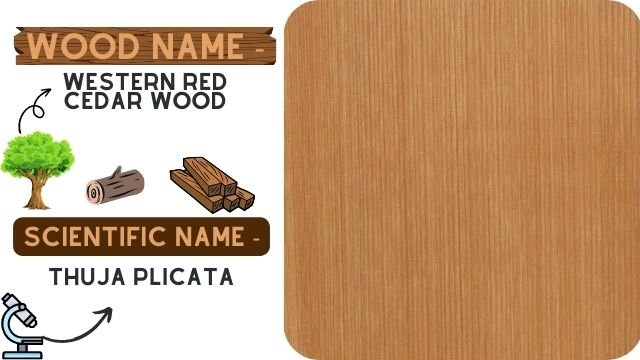
Western Red Cedar is popular ornamental and hedge tree found in North America. It is used for exterior cladding, roofing shingles and greenhouses and has reddish-brown appearance.
Characteristics of western red cedar Wood
| Scientific Name | Thuja Plicata |
| Color | Pinkish Brown |
| Source | Thuja plicata Tree |
| Density | 330 kg/m³ |
| Hardness | 350 on Janka Scale of hardenss |
| Common Uses | Roofing shingles, exterior cladding, etc |
Wood Types Based on Colour
Wood is a natural material that offers a wide range of colors depending on the type of tree and the growing conditions. Here are some wood types based on their natural colors:
- Light-colored woods: These woods are known for their pale shades, which can vary from white to light brown. Maple, birch, ash, beech, and pine are common examples of light-colored woods.
- Medium-colored woods: These woods have a reddish-brown or yellow-brown hue, adding warmth to any space. Oak, cherry, teak, and mahogany are some popular medium-colored woods.
- Dark-colored woods: These woods boast deep brown or black hues, adding a sense of elegance and richness. Walnut, ebony, rosewood, and wenge are well-known dark-colored woods.
- Red-colored woods: These woods have a distinct reddish hue, adding a warm and cozy feel to any room. Cedar, redwood, and padauk are some of the red-colored woods you might come across.
- Yellow-colored woods: These woods have a yellowish hue that can range from light to dark, bringing brightness and cheerfulness to a space. Poplar, yellow pine, and yellow cedar are some of the yellow-colored woods you might find.
It’s important to note that the color of wood can vary greatly depending on the specific tree species, growing conditions, and age of the wood. Additionally, wood can be treated or stained to achieve a specific color or look, providing even more options for creating unique and beautiful designs.
| Light-Colored Woods | Dark-Colored Woods |
|---|---|
| Maple | Walnut |
| Birch | Ebony |
| Ash | Rosewood |
| Beech | Wenge |
| Pine | Mahogany |
| Teak | Blackwood |
| Oak | Cherry |
| Cedar | Padauk |
| Bright Color | Medium Brown Color | Reddish Color | Dark Color |
|---|---|---|---|
| Maple | Acacia | Pear | Ebony |
| Birch | Beech | Larch | Mahogany |
| Ash | Oak | Douglas Fir | Meranti |
| Spruce | Elm | Yew | Bog Oak |
| Linden | Teak | Alder | Walnut |
| Poplar | Ipe | Cherry | Wenge |
| Pine | Koa | Bloodwood | Blackwood |
| Cedar | Sapele | Padauk | Bubinga |
| Holly | Chestnut | Redwood | Cocobolo |
| Bamboo | Sycamore | Purpleheart | Zebrawood |
| Fir | Butternut | Rosewood | Ebony Macassar |
| Hemlock | Walnut Burl | Padouk | African Blackwood |
Color of wood is determined by various factors, such as the species of the tree, growing conditions, and age. Wood can range from light-colored woods, such as maple and birch, to medium-colored woods, such as oak and teak, to dark-colored woods, such as walnut and ebony.
The color of wood can also vary greatly within the same species. In addition, some woods have distinct reddish or yellowish hues. It is important to note that the color of wood can be altered through treatment or staining.
Understanding the natural colors of wood is essential in choosing the right types of wood for specific projects, such as furniture, flooring, or other wood-based items. Overall, the natural beauty and variety of colors that wood provides make it an attractive and versatile material for a wide range of applications.
Price of Wood According to Types
The cost of wood can vary significantly based on various factors, including the types of wood, quality, availability, and location. Pine is one of the most affordable types of wood, with prices ranging from $1 to $5 per board foot.
Oak, a popular choice for furniture and flooring, has a price range of $3 to $12 per board foot. Maple, known for its durability and versatility, ranges from $5 to $14 per board foot.
Cherry, a hardwood with a reddish-brown color, can cost between $6 to $16 per board foot.
More expensive wood types include mahogany, which has a price range of $7 to $28 per board foot, and walnut, which typically costs between $8 to $18 per board foot.
Teak, a highly prized tropical hardwood known for its durability and water resistance, can cost between $16 to $24 per board foot. At the high end of the price range is ebony, a dense black wood that can cost $20 to $30 or more per board foot.
It’s important to keep in mind that these price ranges are only estimates and can vary depending on location and availability.
Additionally, the cost of preparing and finishing the wood, such as sanding and staining, should also be factored into the overall cost of the project.
In general, choosing the right types of wood for a project requires balancing factors such as cost, appearance, and durability.
| Wood Type | Price Range (per board foot) |
|---|---|
| Pine | $1 – $5 |
| Poplar | $2 – $6 |
| Cedar | $3 – $7 |
| Douglas Fir | $3 – $10 |
| Oak | $3 – $12 |
| Birch | $4 – $10 |
| Maple | $5 – $14 |
| Cherry | $6 – $16 |
| Mahogany | $7 – $28 |
| Walnut | $8 – $18 |
| Teak | $16 – $24 |
| Ebony | $20 – $30+ |
| Category | Cheap | Medium | Expensive |
|---|---|---|---|
| Softwood | Pine | Cedar | Redwood |
| Spruce | Hemlock | Douglas Fir | |
| Fir | White Pine | Western Red Cedar | |
| Hardwood | Poplar | Oak | Mahogany |
| Birch | Maple | Walnut | |
| Ash | Beech | Cherry | |
| Hickory | Sycamore | Santos Mahogany | |
| Exotic | Acacia | Teak | Ebony |
| Larch | Ipe | Zebrawood | |
| Meranti | Rosewood | Purpleheart | |
| Bubinga | Padauk | Cocobolo |
Types of Wood Based on Resistance to Weather
| Class of Resistance | Softwoods | Hardwoods |
|---|---|---|
| Resistant | Western Red Cedar | Cumaru, Jatoba, Tigerwood |
| Medium Resistant | Eastern White Pine | Hickory, Red Oak, Sapele |
| Low Resistant | White Fir, Redwood | Poplar, Soft Maple, Red Birch |
| Unstable | Lodgepole Pine, Sitka Spruce | Ebony, Purpleheart, Bocote |
It’s important to note that the resistance to decay/rot can vary depending on the specific species of the wood, as well as the conditions in which it is used and maintained. This table serves as a general guide to the expected resistance to decay/rot of different types of wood.
Frequently Asked Question
What is the difference between wood v/s lumber v/s timber?
Wood is a porous fibrous structural tissue found in the trunks of trees. Timber is wood that has not been processed while lumber is wood after being processed.
What are the 3 different types of wood?
Wood can be classified into 3 types, they are softwood, hardwood and engineered wood.
What is the most common type of wood?
Oak wood is the most commonly used type of wood.
What are the most popular hardwood types in the world?
Some of the best and most used hardwood wood types are as follows:
Balsa wood
Oakwood
Maple wood
Walnut wood
Ashwood
Poplar wood
What is the most popular wood among woodworkers?
Soft maple is the most famous wood among woodworkers as it is not hard on tools.
What are the 2 basic types of wood?
Two main types of wood are Hardwood and Softwood.
What type of wood is best for making furniture?
Hardwood is the best type of wood for making furniture.
What are the top 7 Hardest Wood in the world?
Top 7 hardest wood in the world are mentioned below with their hardness measured in pounds-force (lbf).
1. Australian Buloke – 5,060 pounds-force
2. Schinopsis Brasiliensis – 4,800 pounds-force
3. Schinopsis Balansae – 4,570 pounds-force
4. Lignum vitae – 4,500 pounds-force
5. Piptadenia Macrocarpa – 3,840 pounds-force
6. Snakewood – 3,800 pounds-force
7. Brazilian Olivewood – 3,700 pounds-force
Which wood is the weakest?
Balsa is the softest and lightest wood of commercial woods.
What is the most expensive wood in the world?
Bocote is the most expensive wood. It is a flowering plant from the borage family that is mostly found in Mexico, and Central and South America.
Other woods having the tag of most expensive wood are;
1. Sandalwood
2. Amaranth
3. Agar Wood
4. Blackwood (Ebony)
5. Dalbergia
Which wood is the hardest wood to break?
Lignum vitae is one of the heaviest, hardest woods in the world.
Which is the densest and heaviest wood in the world?
Black Ironwood is the densest and heaviest wood in the world
What is the hardest wood to scratch?
Hickory, with a Janka Hardness rating of 1820, is the hardest wood to scratch, followed by maple wood and ash wood.
Which country uses the maximum amount of wood?
The United States of America uses the most wood produced in the world.
Which is the largest wood-producing country?
China is the largest wood-producing country in the world. Thirty-five percent of the wood is produced in China.
Which is the lightest wood in the world?
Balsa is the lightest wood in the world.
What are the popular types of softwood lumber?
The most popular types of softwood are mentioned below:
1. Pinewood
2. Firwood
3. Redwood lumber
4. Cedarwood
5. Hemlock wood – eastern and western
What are the popular types of Hardwood lumber?
The most popular types of hardwood are mentioned below:
1. Balsa wood
2. Oakwood
3. Maple wood – hard and soft
4. Walnut wood
5. Ashwood
6. Poplar wood
14 thoughts on “40+ Different Types of Wood | Lumber Or Wood Types | Popular Hard Wood and Soft Wood”